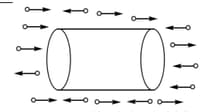Imagine a gravity free space consisting of tiny particles moving horizontally at speed from both left and right. A uniform cylindrical body with its axis of symmetry parallel to the direction of motion of particles is released from rest as shown

The particles bombard the body uniformly from both left and right. Collision of particles with the right end of the cylinder is perfectly elastic while those with the left are perfectly inelastic, though the particles do not stick to the cylinder after the collision. Neglect the heat produced during collision. Mark the correct statements.

Important Questions on Laws of Motion


Assertion (A): When we bounce a ball on the ground, it comes to rest after a few bounces, losing all its energy. This is an example of violation of conservation of energy.
Reason (R): Energy can change from one form to another but the total energy is always conserved.
Which of the following is true?

